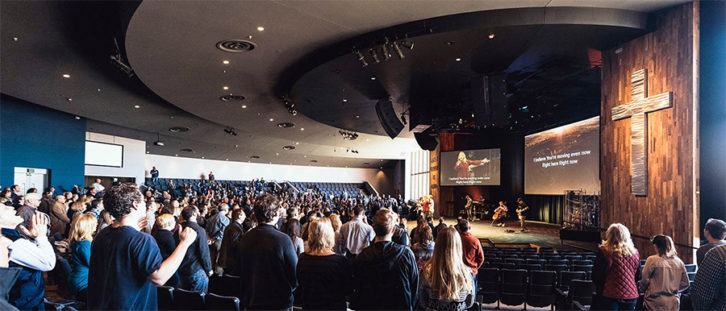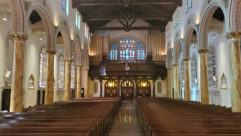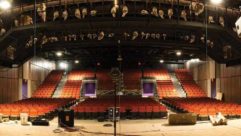
By R. Jim Brown – From TheArchive@SVConline: First published Jan 1, 2001
WHY THIS MATTERS: This is a great piece to give your clients a high level overview of the impact of sound systems and sound system pros. From esteemed AES Life Fellow, author, and presenter R. Jim Brown
“I want to sell this church their last sound system.” Better sound contractors make this kind of statement with good reason: strange as it seems, most churches are so afraid of buying sound systems that they do it three or four times before they finally get one that works well enough to meet their needs!
The first system is purchased when they build the church and the architect says he’ll design it. What really happens is that he passes the work along to a sound contractor, usually the new kid on the block who is trying to get his foot in the door by doing the designs for free. He prints up a list of whatever equipment he has the best deals on (and which his competitors aren’t franchised for)and sends it along as a specification.
The system goes out to bid. Often the hero is the low bidder; either the budding designer or someone else who knows a little about sound and can propose an even cheaper system. Since there’s no knowledgeable authority to decide which is the better deal, the lowest bidder usually wins. But neither system is likely to meet the church’s needs anyway, and most are replaced in a year or two.
Why are these first systems replaced? Some of the most common problems are feedback, poor speech intelligibility and muddy music caused by too much reverberation. Often the system can’t be hear don the platform, or there are dead spots, hot spots and just plain unpleasant sound quality. And so we move on to system number two.
There are several variations on system number two. A common scenario has members of the praise and worship team making exploratory visits to their friendly musical instrument and recording equipment store, where everyone either is, has been or knows someone who is a roadie for a band. And all of those folks know how to put together a sound system — after all, they’ve done it every night for their bar band and got paid for it! Add to that the fact that they’re on commission, selling all kinds of sound equipment designed to be used by bar bands. And gee whiz, isn’t a church system just like a bigger bar band system? So we have another designer who is anxious to sell his equipment but doesn’t know anything about the specific requirements for church sound systems.
Another common variation on system number two starts with someone in the congregation who is either a sound contractor or knows someone who is a sound contractor. And because he’s a friend, or a friend of a friend, he’s asked to design the next system.Maybe he’s actually qualified to do it. But more often his specialty is paging systems for offices and factories or touring systems for rock bands. So here’s another designer who doesn’t know enough about the particulars to get the design right.
Other common variations on the theme have electronics engineers or stereo enthusiasts heading down to the local Radio Shack or music store. They usually believe that everything will be fine if they just install the latest exotic cables and super audiophile amplifiers, loudspeakers and microphones.
So this second time around, the church chooses a designer because he’s connected somehow to the congregation. He’s got his heart in the right place but still has no proven ability to put together a good church sound system. System number two is purchased and installed and rarely works any better than the first. But it’s now a couple of years later, twice as much money was spent asplanned, and attendance is sagging because of the poor sound. The pastor still has poor communication with the congregation, and the praise and worship team sounds more like noise than inspiration.
Desperate measures are called for. If they’re lucky, the church comes to the realization that they’d better find someone who really knows what they’re doing: a proven expert with a track record. That someone is the acoustic consultant who specializes in sound system design for churches and performance spaces. This is the person whois ready to sell the house of worship its last sound system.
ACOUSTICS IN TODAY’S CHURCH
Churches are built around communication — verbal, musical and emotional — as well as worship. The minister communicates with the congregation by preaching, leading prayers and announcing church activities. Music communicates ideas and inspiration while simultaneously enhancing the worship experience through emotional involvement. The acoustics of the worship space have a profound effect on all of these functions.
A space is said to have good acoustics if it provides a sound environment conducive to the way it is used. For a worship space to have good acoustics it must allow good verbal and musical communication. It has poor acoustics if it makes that communication difficult. See the sidebar for some of the unwanted effects of poor acoustics.
The acoustics of a space are determined by its architecture— its geometric shape and the way in which it is finished— and by the number of occupants at any given time. Sound waves travel in approximately straight lines, bouncing off hard surfaces or being absorbed, or “soaked up,” by soft ones. The sound from a person speaking in a large space with hard walls (glass, stone, tile, wood, etc.) will bounce around a longtime before dying out, and it doesn’t take much vocal effort to be heard (but not understood) everywhere in it. Such a space is said to be reverberant or “live,” and the sound bouncing around the room is called reverberation. Similarly, the sound from a person speaking in a room with soft walls (curtains, carpets, seat cushions, people, acoustic tiles, etc.) will not bounce much at all before it dies out. It will take a lot of vocal effort to be heard over an equivalent distance in this non-reverberant or“dead” space, but the sound which does get through will be easier to understand.
Sound travels at a definite speed (a little faster than 1 foot per millisecond). Sound from a person speaking in a very reverberant space will consist of one sound wave traveling in a straight line and a lot of sound waves that have bounced around the room for a long time. All of these sound waves arrive at the listener at different times. This reverberation can be a thing of great beauty, as the listener is able to hear many notes of a musical solo layered on top of one another, enriching the sound beyond measure. Reverberation can also be disastrous, as the listener is subjected to different parts of a word or sentence piled on top of each other at the same instant, making speech difficult to understand. This is the basic conflict of acoustics, that what is great for music is bad for speech. But well-designed sound system can overcome this kind of conflict.
Most contemporary music is written to be performed in less reverberant spaces and is hurt by reverberation. This is because tempos in modern music are faster, bass lines are more prominent, and lyrics and rhythms are usually more important. Reverberation that piles notes on top of each other blurs rhythms and lyrics. At the same time, some reverberation is very desirable to enhance singing by the choir and the congregation. It is hard to sing in a dead, non-reverberant church.
Providing a good reverberant environment is much more complicated than simply making a large space with hard surfaces.Some geometric shapes work much better than others, and some can be downright awful no matter what the intended use. Some kinds of curved surfaces can cause destructive focusing of sound; a wall in the wrong place or at the wrong angle can cause a troublesome echo.A good reverberant environment is one that provides a pleasing mix of direct and reflected sound to enhance the musical experience.This is accomplished by a careful combination of regular and irregular room geometries and surface finishes.
Another important consideration is that the worship space must be quiet enough so that worshippers are not distracted by noise that might interfere with music or speech. Sounds that originate outside the church (street traffic, airplanes, etc.) and inside the church (ventilation systems, elevators, children in a nursery, etc.) must be controlled. This kind of acoustic problem is called noise control. The solutions are good structural design, thoughtful building layout to keep major noise sources away from worship spaces, and proper design of the noisy systems.
DOING IT RIGHT THE FIRST TIME
Here are some of the things a good consultant will do when a church (or a new sound system for an existing house of worship) is being designed.
- Send a questionnaire to be filled in by the pastor and committee members about how the sound system will be used. This helps the consultant understand the congregation’s unique needs, and it gets the church committee to focus attention on the project.
- Once the questionnaires have been returned, meet with the respondants and other key members to work through all the important planning decisions that can affect acoustics and audio.
- If a new system is to be installed in an existing space, make acoustic measurements in the space to be used at the design stage.
- Prepare a written report summarizing all of the decisions reached during the meeting. Describe all of the uses of the worship space and the functions that the sound system should provide, along with a rough budget for the system.
- Work with the architect to get the acoustics right for the intended uses and to control noise from both inside (HVAC systems, motors, transformers, door latches, footsteps in the hall) and outside the building (highways, airplanes).
- Work with the electrical engineer to get clean technical power and grounding so that everyday operation of the system is not troubled by hums and buzzes. Ensure the quality of the conduits for sound system wiring.
- Work with the mechanical engineer to make sure that noise fromHVAC systems will not intrude in the worship space.
- Work with the architect to find good ways to conceal loudspeakers, either by building them into ceilings and walls or by turning them into design elements that don’t look like loudspeakers.
- Work with the architect and the congregation on both the shape and layout of the worship space. For example, make sure the choir is in a location where it can be miked with-out feedback. Make sure the positioning of the choir, praise band, organ and congregation allows the choir to be heard by the congregation without being overpowered by the praise band or the organ.
- Design a sound system that provides both good intelligibility for spoken word and clean dynamic sound for music and that is well-balanced throughout the congregation.
- Design system elements that provide good sound to those on the platform.
- Review architectural, electrical and mechanical drawings before they go out to bid to make sure that things worked out at the design stage actually show up satisfactorily on the drawings.
- Help the congregation work through budget issues. Sound systems nearly always cost more than the congregation expects or is prepared to pay. Some parts of the system can usually be deferred and purchased later, but it’s usually necessary to dedicate more money to the sound system than was originally planned. These are sometimes hard decisions, and it’s important to be working on budget issues from the beginning.
- Document the system thoroughly with drawings, specifications and a specific equipment list so that it can be competitively purchased from a good local contractor.
- Help find a good contractor to install the system, and help to bid or negotiate the purchase with that contractor.
- Coordinate with the contractor during the installation process to make sure things are done right, and work through the conflicts with other building elements that inevitably develop in any major construction project.
- Once the system is installed and tested, come in to work with the sound contractor to tune and balance the system to the worship space and to verify that the contractor did his work well.
THINGS TO KEEP IN MIND
You can be the consultant who sells a house of worship its last sound system. By considering the acoustics of the space and working carefully with all contractors, you can design and help install the sound system that serves all the requirements of the space and can expand and grow with the church. You’ll earn gratitude, respect— and referrals — for a job well done.
Provide good acoustic and sound system advice early in the design process — before construction begins. Acoustics greatly affect speech and music in a church and are determined entirely by the architecture and finishes of the room.
Fixing the acoustics after the building is built is often quite expensive; getting it right before construction starts is not.
Remind the church committee or pastor that hiring the right sound system consultant early in the project will save them money in the long term. It is always cheaper and better to do it right the first time.
If budgets are limited, it is far better to have the design work done correctly and to defer the purchase of options such as an organ or a sound system for later.
If your company does not have the resources on staff to provide acoustic and sound system services, consultants are good insurance against serious problems later on.
Contemporary music and traditional European music make very different demands on room acoustics. It is quite costly (and often impractical) to provide a workable acoustic environment for both forms in the same space. No sound system can remove reverberation from a space, but if contemporary music will be part of worship, reverberation must be carefully controlled.
Any architect who knows anything about acoustics will hire a good acoustic consultant for any church or other large space. And the opposite is also true: Any architect who doesn’t hire a good acoustic consultant for these spaces thereby demonstrates his incompetence. Effective, high-quality sound systems can often be made invisible if the consultant and the architect work together.
Some consequences of poor acoustic and sound system design
SPEECH IS UN-INTELLIGIBLE
Everyone can hear the preacher, but most can’t understand anything the preacher says. Or, at best, they have to strain to understand. The results are wandering attention and poor communication between the praise and worship team and the congregation. Worshippers feel isolated from the service; their understanding of the message is hampered, and their participation flags. This can directly impact attendance and contributions to parish life.
CHOIR AND CONGREGATIONAL SINGING SUFFERS
Bad acoustics can make choir and congregational singing muffled and forced. The choir just can’t seem to be heard, no matter how hard they try, and the congregation doesn’t hear the choir or themselves well enough to join in. Also, the organ or other musical instruments may sound dull and lifeless.
EXPENSIVE FIXES MUST BE MADE
When the acoustics are bad, music and worship will not sound good until they are fixed, often at great cost and with a big mess during construction.
SOUND SYSTEM IS NOT PROPERLY PROVIDED FOR
If there is no adequate sound system design, the electrical conduit for loudspeakers, microphones, power and control of the system is either not provided or may be provided in the wrong place. One possible solution to some really difficult acoustic problems can be miniature loudspeakers mounted under or on the backs of pews. Adding conduit after the building is completed can often be so expensive or so ugly that desired functions or solutions have to be eliminated.
NOISE INTRUDES ON WORSHIP
HVAC systems may intrude on worship. The units can be silenced, but ducting may need to be removed and re-sized or re-routed, duct silencers added, and motors replaced or remounted. Remounting the motors can be accomplished easily, but replacement motors may not fit; necessary ductwork can be very expensive or impossible due to lack of space. Furthermore, sound from meeting rooms and nurseries can interfere with worship services.
 Jim Brown was the principal of the Audio Systems Group Inc., a Chicago-based consulting firm specializing in the design of sound systems for churches, performance spaces, stadiums and arenas. He is an AES Life fellow and served as a popular industry author, committee member, and presenter for decades.
Jim Brown was the principal of the Audio Systems Group Inc., a Chicago-based consulting firm specializing in the design of sound systems for churches, performance spaces, stadiums and arenas. He is an AES Life fellow and served as a popular industry author, committee member, and presenter for decades.










